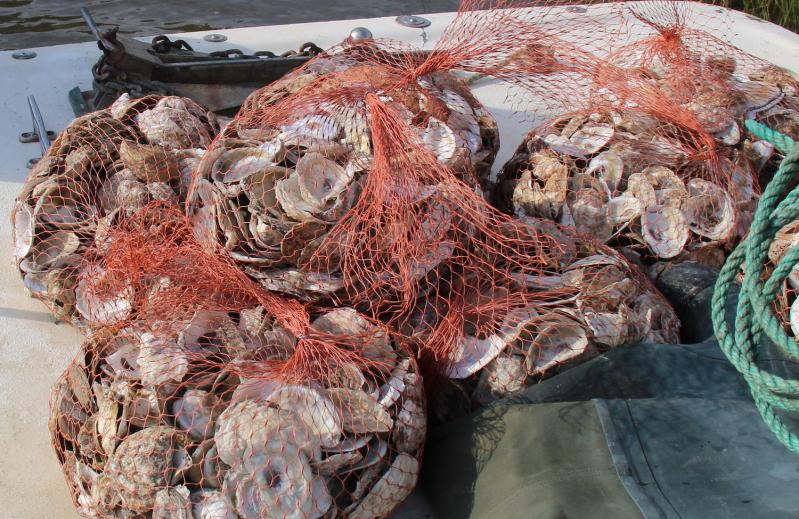In a lengthy discussion at their meeting on the Monday, several of the East Hampton Town Trustees sharply questioned the wisdom of expanding what has been called an oyster restoration effort in Georgica Pond, along with the construction of an oyster reef, as has been requested by scientists at Stony Brook University’s School of Marine and Atmospheric Sciences.
Michael Doall, associate director for bivalve restoration and aquaculture there, had proposed an expansion of the oyster effort in Georgica Pond and the construction of a reef at the trustees’ Jan. 27 meeting. At the time, the trustees deferred a decision until other users of the pond, including baymen, had been heard.
Oyster seeds, in cages to protect against predation, were initially installed in three locations in the pond in 2019. Oyster spat-on-shell, also in cages, was deployed in 2021, and small “test oyster reefs” using shell bags containing spat-on-shell were installed in two sites in 2022. Mr. Doall cited a high survival rate, 40 to 50 percent, in advocating for an expansion of the program.
When the trustees met on March 24, they heard from Mr. Doall as well as Christopher Gobler of the School of Marine and Atmospheric Sciences, who has monitored the quality of waters under trustee jurisdiction for the past 11 years. Both advocated for a continuation of the program, an expansion of which would require trustee permission.
One oyster can filter 50 gallons of water per day, and oysters are able to create strong reef communities and can mitigate harmful algal blooms by eliminating excess nutrients from the water. The trustees have permitted pilot programs in their waterways in which students have built oyster reefs under the tutelage of South Fork Sea Farmers, the nonprofit educational arm of the town’s shellfish hatchery and community oyster garden program.
But “the Georgica oyster reef project keeps me awake at night,” Francis Bock, the trustees’ presiding officer, told his colleagues on Monday. Historically, “I, for the life of me, have never seen any reference to oysters in Georgica Pond,” yet “it’s being represented as a restoration project.” Any permit should refer to “an introduction project, because that’s exactly what it is,” he said. “I think that if we’re going to go ahead with that, there’s going to have to be some pretty severe monitoring of the growth, where it’s going.”
The pond is “a closed ecosystem,” Mr. Bock continued, “and I don’t want to be a board that drastically changed that entire closed ecosystem. The unintended consequences, I think, could be quite severe.”
There was agreement among several trustees. “From the beginning, I’ve looked at this as somewhat vanity research projects,” Jim Grimes said. “We’re essentially raising oysters in this little closed environment.” The filter-feeding bivalves have “no measurable impact on the water quality in Georgica Pond,” he said, adding that water quality has steadily improved since the introduction of the aquatic weed harvester. The biannual letting of the pond to the Atlantic Ocean “has been the biggest impact on water quality.”
“When I asked Dr. Gobler what were the objectives, he said it’s not a scientific experiment,” said Patrice Dalton.
“That said, why are we doing this?” Mr. Grimes asked.
There is interest “by a constituency around the pond to utilize this tool to help improve water quality,” John Aldred said. Should the trustees approve an expansion of the program, “we have to state our concerns clearly, and make sure the monitoring plan that’s proposed addresses those concerns.”
Mr. Bock reiterated that he has seen no mention in trustee records of oysters in Georgica Pond. “It’s concerning that we’re the ones who want to introduce it.” The pond is apparently a site in which oysters can thrive, so “why weren’t they there before? I don’t understand it.” He was not suggesting the project be terminated, he said, but rather that it “proceed slowly,” likening it to the South Fork Wind farm’s export cable, for which the trustees granted an easement so the wind farm’s developers could bury it under the Wainscott beach under their jurisdiction.
“If it’s such a great environment for them,” he asked, “what’s going to prevent them from overtaking the pond?”
Christopher Carillo, the trustees’ attorney, suggested that there should be “clear guidelines as to what decommissioning that project looks like” should the project be deemed unsuccessful.
The discussion was timely, Mr. Aldred said, coming “before there was a meeting between the baymen and Mike Doall and the trustees.”
“It’s considered ecological engineering,” Ms. Dalton said, “when you introduce something that’s never been there.”




